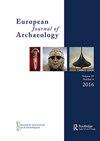青铜时代早期的性别爱尔兰和苏格兰
IF 1.4
2区 历史学
0 ARCHAEOLOGY
引用次数: 1
摘要
长期以来,性别一直被认为是整个欧洲青铜时代社区的一个重要结构因素。一些青铜时代早期的墓地给人留下了强烈的二元性别印象,根据这一证据发展起来的社会组织模式极大地影响了整个大陆对性别的理解。这篇文章关注的是两个证据更模糊的地区:爱尔兰和苏格兰,在这两个地区,个别墓地的特殊做法与更广泛的趋势相结合。不同社区之间的性别表达方式存在根本差异,这无法用当前欧洲青铜时代的宏大叙事来捕捉或解释。相反,作者认为,性别可能是微妙的、有背景的,在不同的时间对各个社区的重要性不同,不一定是统一欧洲青铜时代的共同特征。本文章由计算机程序翻译,如有差异,请以英文原文为准。
Gender in Earlier Bronze Age Ireland and Scotland
Gender has long been recognized as an important structuring agent in Bronze Age communities across Europe. A strong impression of binary gender emerges from some Early Bronze Age cemeteries, and models of social organization developed from this evidence have greatly influenced understandings of gender across the continent. This article focuses on two regions with more equivocal evidence: Ireland and Scotland, where idiosyncratic practices characterize individual cemeteries alongside wider trends. Expressions of gender varied in radical ways between different communities, and this cannot be captured or explained by the current grand narratives for the European Bronze Age. Instead, the author argues that gender could be subtle, contextual, and of varying importance to individual communities at different times, not necessarily a common feature unifying the European Bronze Age.
求助全文
通过发布文献求助,成功后即可免费获取论文全文。
去求助
来源期刊

European Journal of Archaeology
ARCHAEOLOGY-
CiteScore
3.40
自引率
6.70%
发文量
58
期刊介绍:
The publication organ of the European Association of Archaeologists, the European Journal of Archaeology seeks to promote open debate amongst archaeologists committed to a new idea of Europe in which there is more communication across national frontiers and more interest in interpretation. The journal accepts not only new empirical data and new interpretations of the past but also encourages debate about the role archaeology plays in society, how it should be organized in a changing Europe, and the ethics of archaeological practice. All periods are covered; papers, review articles, interviews and short "debate" pieces are all sought. Whilst English is the primary language of publication in the EJA, papers submitted in French or German will be given equal consideration.
 求助内容:
求助内容: 应助结果提醒方式:
应助结果提醒方式:


